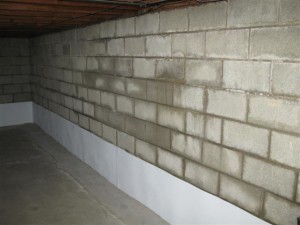 When you are shopping for a basement waterproofing system you may find there isn’t just one way to waterproof a basement. There are several options that all accomplish the same goal of keeping your basement dry. It may take some time to determine which one is right for you and your home.
When you are shopping for a basement waterproofing system you may find there isn’t just one way to waterproof a basement. There are several options that all accomplish the same goal of keeping your basement dry. It may take some time to determine which one is right for you and your home.
Exterior Waterproofing
Many contractors swear by exterior waterproofing. It is effective at keeping the water out but it is evasive in retrofit jobs. The contractor has to excavate around the foundation in order to install a retrofit exterior waterproofing system. The added labor can add to the price tag and the length of the job. Exterior waterproofing systems install a membrane or sheeting to the outside of the foundation directing the water down the wall to a exterior French drain that leads the water out into the yard away from the house. Many new construction home builders install a foundation waterproofing system when during construction. However, it is important to know that exterior waterproofing is more than black tar or waterproof foundation paint. That black stuff is nothing more than a vapor barrier. Waterproof sheeting is more effective and will tie better into the whole waterproofing system. It is called a basement system because it has multiple parts working together to control and divert water.
Interior Waterproofing
The Interior waterproofing system takes the approach from the inside of the basement. This basement system typically uses a sump pump that pulls the water from below the foundation as well as an interior French drain or trench around the perimeter of the basement floor. This allows for any water that may enter the basement to get out. Trapping water inside is probably the worst thing you could do to a basement. The best basement system does its best to keep the water out but also allows a way for the water to escape. You don’t want the waterproofing that doesn’t account for an escape for inside moisture because just living in a home, taking showers, or using the heater will create inside moisture that needs a way to get out.
The problem with interior waterproofing systems is that they aren’t very pretty and aren’t a good solution for someone with an already finished basement. There are wall systems that allow for an interior waterproofing system behind the finished wall but interior systems are best installed on unfinished basements. Always waterproof the basement and deal with any water issues before you finish the basement. If you don’t you may end up tearing out the finished basement when your water problem returns.
Among the generic interior and exterior basement systems there are several manufacturer’s and contractor’s approaches. Most of them work at solving the issues but have different advantages and drawbacks. Make sure that if you choose an interior basement system that it is a closed channel. Open channels are dangerous because they allow for radon and other soil gases to come into your home. Breathing in dangerous levels of radon can cause lung cancer even in nonsmokers. Other than that most of the systems are relatively comparable in way of accomplishing the goal of a dry basement.
It is important to look at all the options and decide which one is right for you. Most waterproofing contractors offer a free inspection and can give you more information on the systems they install. Have multiple contractors come and inspect your basement to get the best picture of what is right for you. Choosing the contractor you trust is another part of the equation. Make sure you choose a contractor and company who is right for you and your home.